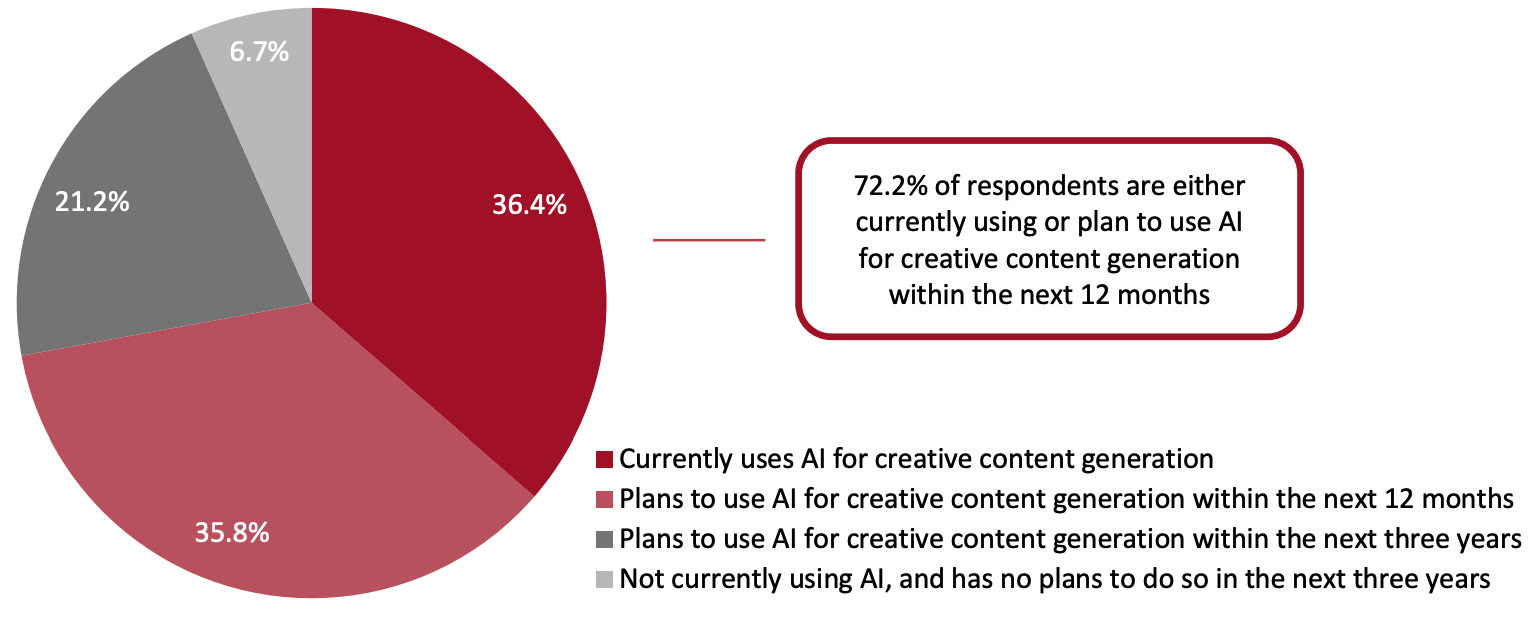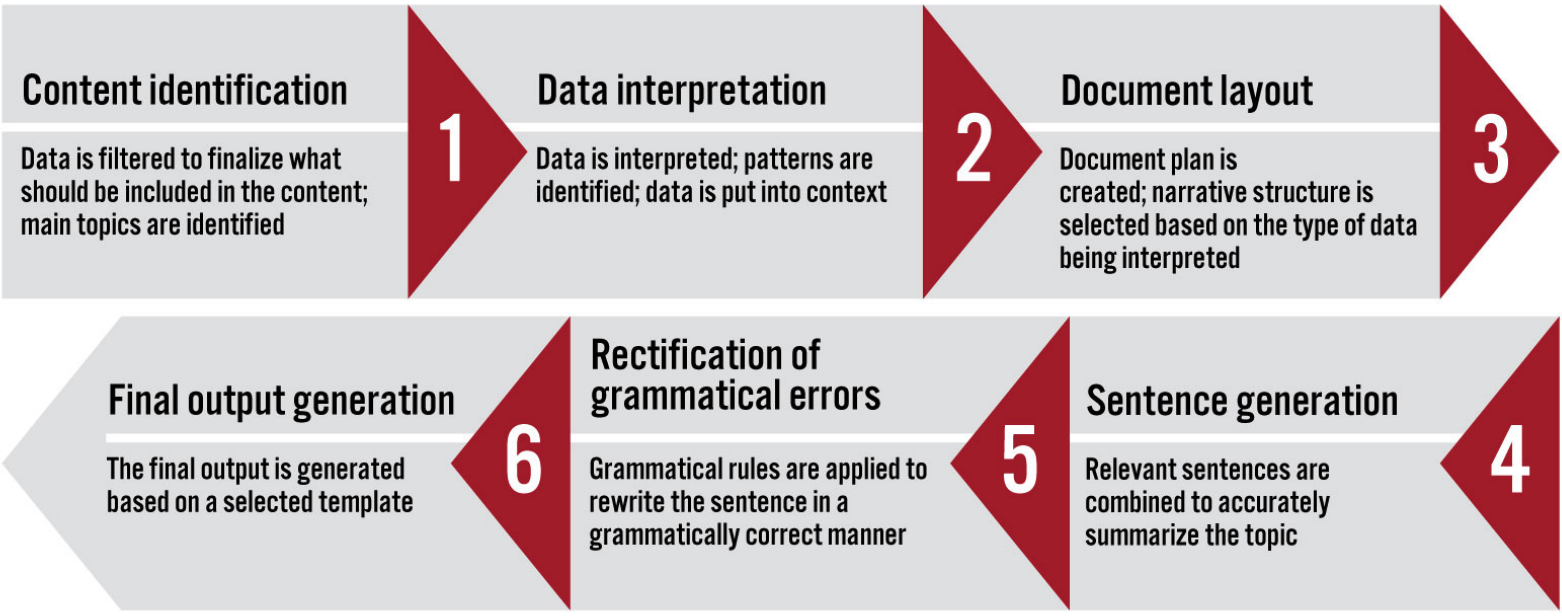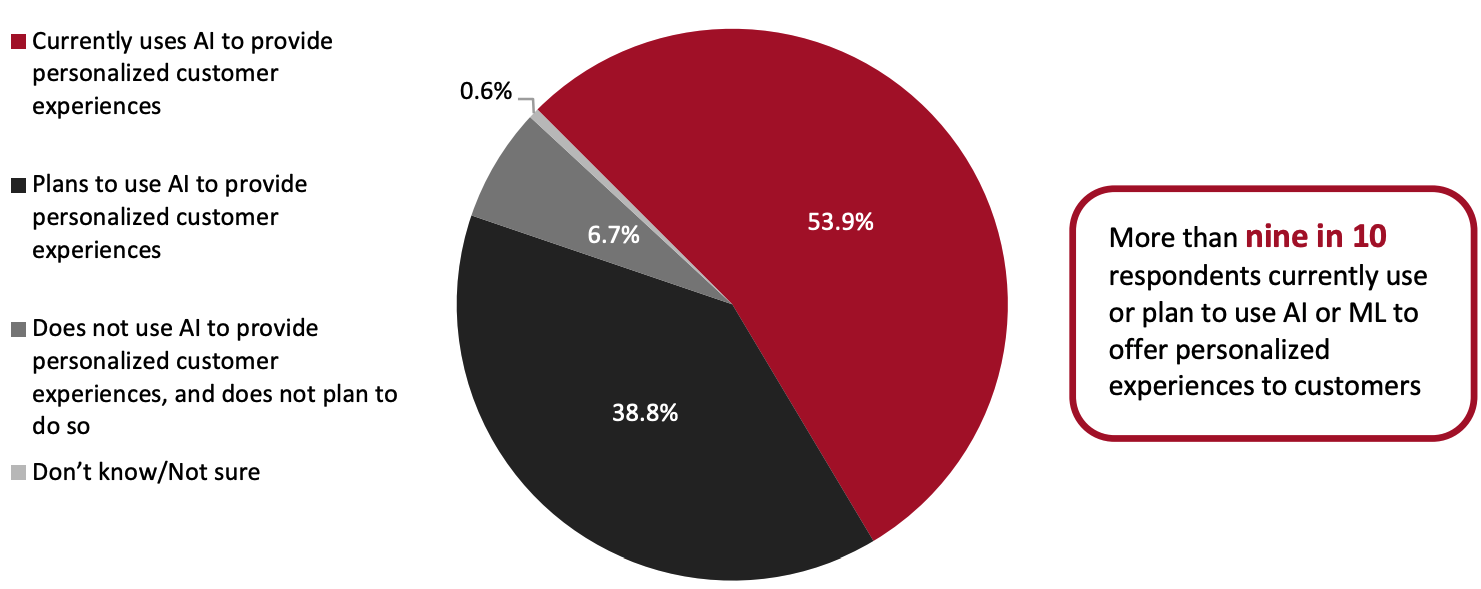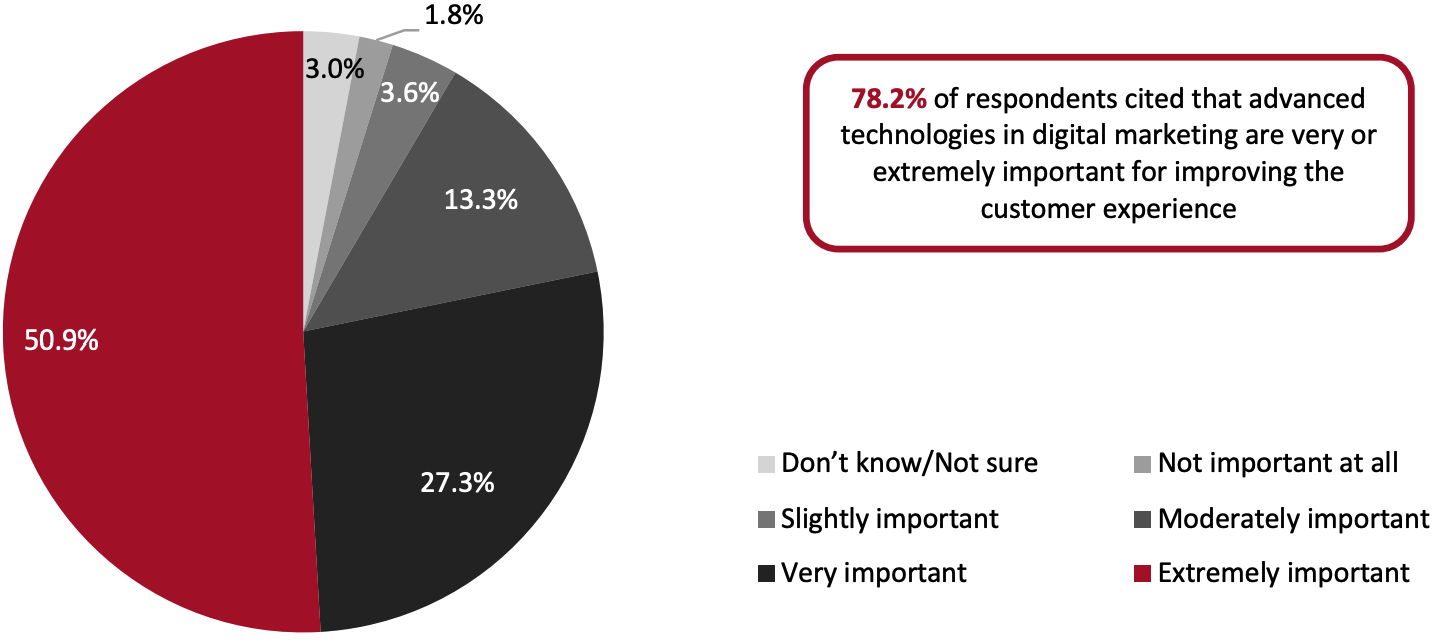
albert Chan
Introduction
What’s the Story? Digital marketing continues to evolve as organizations increasingly turn to advanced technologies to enhance their capabilities, including artificial intelligence (AI), machine learning (ML) and deep learning. AI-enabled marketing technologies drive automated decisions based on data collection, analysis and additional observations of customers or economic trends that may impact marketing efforts, such as product demand and supply. AI tools use data to understand the best ways to communicate with customers and then provide automated tailored messages without intervention from marketing team members. Organizations are using AI not only for operational purposes including predictive analytics and customer segmentation, but also to generate creative content, improve personalization initiatives and facilitate the more effective use of first-party data (data that organizations collect directly from their customers). In this report, we explore the evolving nature of AI in digital marketing, presenting our analysis of findings from a November 2021 Coresight Research survey of 165 US-based executives whose companies (across various industries) use advanced technologies in digital marketing or plan to do so in the next three years. This report is sponsored by Persado, an AI-enabled technology provider that helps businesses use the right words at the right time in every customer interaction. Why It Matters We expect the use of AI to be a core focus area in digital marketing as organizations look for innovative and effective ways to enhance their bottom line through marketing. We identify three outcomes of AI that will support its increasing adoption in digital marketing moving forward:- AI-based language platforms enable marketers in the retail, finance and media industries to generate engaging creative content. Companies leverage these AI-enabled platforms to select the most appropriate words and phrases that have the maximum impact on their readers/customers.
- AI allows marketers to offer a personalized customer experience by analyzing detailed data such as geolocation data, purchase history, social media interactions and browsing data. Such analysis informs improved customer communication, product recommendations, dynamic pricing and customized ad targeting.
- AI can improve how businesses use first-party data, which is particularly important due to rising privacy regulations. AI allows digital marketers to efficiently collect, manage and analyze first-party data to gain meaningful customer insights without requiring any personal information.
AI-Powered Language: Coresight Research x Persado Analysis
Content Generation Today, digital marketers use AI to distribute, manage and analyze content as well as for creative content generation—the process of identifying topic ideas that appeal to customers, creating written or visual content around those ideas and making that information accessible in multiple formats. Natural language processing (NLP) is a key AI-driven technology in creative content generation; it interprets human speech or text using software. Our survey found that using NLP for this purpose is one of the top three most significant ways in which organizations are experimenting with AI in digital marketing—behind facial and voice recognition, and providing a personalized channel experience. All three of these technology applications were cited by at least four in 10 respondents (see Figure 1).Figure 1. Top Five Most Significant Ways in Which Organizations Are Experimenting with AI in Digital Marketing (% of Respondents) [caption id="attachment_140210" align="aligncenter" width="700"]
 Respondents were asked to select up to three most significant ways in which they are experimenting with AI in digital marketing
Respondents were asked to select up to three most significant ways in which they are experimenting with AI in digital marketingBase: 165 US-based executives
Source: Coresight Research[/caption] There are five common applications of NLP:
- Natural language generation (NLG)—using AI programming to produce written or spoken narratives from a data set, summarizing insights from multiple data points
- Speech-to-text conversion—translating broken language into text
- Text-to-speech conversion—accepting, interpreting and producing audible language
- Text processing—using little to no human intervention to identify and extract relevant information to generate meaningful insights
- Chatbots—answering specific questions and providing customized answers
Figure 2. Whether US Organizations Use or Plan To Use AI for Creative Content Generation (% of Respondents) [caption id="attachment_140212" align="aligncenter" width="700"]
 Base: 165 US-based executives
Base: 165 US-based executivesSource: Coresight Research[/caption] Marketers should treat AI as a “colleague,” making the AI-enabled platform accountable for the performance of its marketing outputs. According to our survey, 78.3% of respondents hold AI accountable for creative development and execution—meaning that marketers can track the impact of words and phrases that are being generated via AI. By implementing a data-driven process, marketers can also quantify their return on marketing spend on AI. NLG significantly reduces the time taken to produce thousands of messages by automating the process. The AI tool selects the most appropriate words and phrases for every message that is being conveyed to customers. In addition to enhancing efficiency, NLG makes datasets more insightful and understandable for businesses, using numerical information and mathematical formulas to extract patterns from any given database and translating them into text. NLG also supports organizations in improving their personalization efforts, which we discuss in more detail later in this report. We present the key steps in the application of NLG in Figure 3.
Figure 3. NLG Process Flow: Six Key Steps [caption id="attachment_140213" align="aligncenter" width="700"]
 Source: SearchEnterprise.ai/Coresight Research[/caption]
Below, we highlight examples of organizations globally that are currently using NLG.
Source: SearchEnterprise.ai/Coresight Research[/caption]
Below, we highlight examples of organizations globally that are currently using NLG.
- Commerzbank, a Germany-based bank, uses AI to generate its equity research reports. In an interview published by The Financial Times in June 2018, Commerzbank's R&D Director, Michael Spitz, said that the technology could perform around 75% of a human equity analyst’s work.
- US-based investment bank and financial services holding company JPMorgan Chase uses an AI-based language platform for content creation. In 2019, the company signed a five-year deal with Persado for creative generation. By leveraging NLG, the company has seen up to a 450% lift in click-through rates on ads rendered by Persado, compared with others in the 50%–200% range, according to JPMorgan Chase.
- US newspaper The Washington Post uses its in-house NLG tool, Heliograf, to create news articles and social media posts. According to Scot Gillespie, Chief Technology Officer at The Washington Post, “Technology like Heliograf can be transformative for a newsroom, greatly expanding the breadth of coverage and allowing journalists to focus more on in-depth reporting.”
- Our survey found that 74.5% of respondents agree or strongly agree that using AI helps organizations manage challenges related to offering personalized customer experiences.
- More than half of all respondents (53.9%) are currently using AI or ML to offer a personalized experience to customers, and only 6.7% do not leverage or plan to leverage these advanced technologies (see Figure 4).
Figure 4. Whether US Organizations Use or Plan To Use AI/ML To Offer a Personalized Experience to Customers (% of Respondents) [caption id="attachment_140214" align="aligncenter" width="700"]
 Base: 165 US-based executives
Base: 165 US-based executivesSource: Coresight Research[/caption] Organizations across multiple industries are experimenting with a combination of AI-driven technologies to generate personalized content for customers. According to a report published by Boston Consulting Group in October 2021, AI could generate incremental revenue of up to $200 billion for the Fortune 500, and up to $800 billion worldwide, over the next 10 years. AI technology solution providers such as Persado help organizations generate personalized creative content. These companies use algorithms that take into account vast databases of tagged words and phrases. The tools automatically select the words and phrases that most resonate with their intended readers/recipients. In this way, both the content and the targeting of particular messages are automated—driving incremental sales and brand value. Below, we present examples of organizations that are using AI to offer engaging personalized content.
- Vodafone, an Italy-based telecom provider, has been using Persado’s AI tool to deliver personalized content since 2012. In generating customized messages, the tool identifies specific words and phrases that have maximum impact on customers and so can increase customer engagement.
- The American Marketing Association uses an AI-driven personalization platform, Rasa.io, to generate customized email subject lines based on member interest data, highlighting the most relevant and interesting content to each newsletter recipient. Since the company started using this tool in 2019, it has witnessed an increase of 42% in the monthly subscriber engagement rate, as reported by the company in November 2021.
- First-party data—Information that is collected directly from the audience and includes data gathered through form submissions, website cookies, a customer service center, purchase history or any other engagement; can be either online or offline
- Second-party data—Data collected by another organization that can boost an organization’s overall insights into its audience
- Third-party data—Information collected by companies that do not have a direct relationship with consumers; usually aggregated from multiple sources; can be licensed or purchased from a data management platform or a third-party data vendor that compiles anonymous visitor information such as browsing behavior, location information, app usage or other real-world interactions
- Social media players including Facebook and Twitter have already removed third-party data from their advertising platforms in 2018 and 2019 respectively, due to privacy regulations restricting the use of third-party cookies. In August 2019, Twitter also issued a public apology to its users for using people’s personal information for advertising purposes.
- In June 2021, Internet giant Google announced that by the end of 2023, its Chrome browser would begin to remove support for third-party cookies. Cookies are stored as a single line of code on a user’s hard disc; these cookies help marketers create behavioral profiles for Internet users that they can use for advertisement targeting. With the blocking of third-party cookies, the reliance on first-party data will increase substantially.
Figure 5. The Importance of the Effective Use of First-Party Data in Using Advanced Technologies for Digital Marketing (% of Respondents) [caption id="attachment_140215" align="aligncenter" width="700"]
 Base: 165 US-based executives
Base: 165 US-based executivesSource: Coresight Research[/caption] Our survey found that 86.1% of respondents are already using first-party data for marketing purposes. First-party data provides marketers with unique information about their customers, leading to a better understanding of customers from which retailers can improve the accuracy and relevance of their messaging. This elevates customer satisfaction and drives greater brand recognition, which in turn lead to improvements in the top line. In Figure 6, we highlight the top benefits of using first-party data, as cited by our survey respondents.
Figure 6. Benefits of Using First-Party Data (% of Respondents) [caption id="attachment_140216" align="aligncenter" width="700"]
 Respondents were asked to select the top three benefits derived from the use of first-party data
Respondents were asked to select the top three benefits derived from the use of first-party dataBase: 142 US-based executives whose organizations use first-party data for marketing purposes
Source: Coresight Research[/caption] Enhanced Customer Experience All of the above-mentioned trends (the use of AI for content generation, improved personalization and the effective use of first-party data) ultimately drive enhancements in the customer experience. Maximizing customer satisfaction is essential for every business as it directly impacts revenues. Around half of all survey respondents agree that advanced technologies (such as AI) in digital marketing are “extremely important” for improving the customer experience (see Figure 7).
Figure 7. The Importance of Using Advanced Technologies in Digital Marketing To Improve the Customer Experience (% of Respondents) [caption id="attachment_140217" align="aligncenter" width="700"]
 Base: 165 US-based executives
Base: 165 US-based executivesSource: Coresight Research[/caption] One of the ways in which organizations are using AI to enhance customer satisfaction is through AI-enabled chatbots, which communicate in a natural manner with customers and act as virtual shopping assistants, for example. Chatbots use NLP technology to duplicate and mimic human conversations through text. It evaluates users’ reactions and purchase history and gives them personalized offers and recommendations within seconds. These chatbots improve customer satisfaction by reducing the response time and offering round-the-clock support to customers. In our survey, 64.0% of the respondents have cited that they are currently using AI chatbots to offer personalized experiences to customers (see Figure 8).
Figure 8. Ways in Which Organizations Are Using AI To Improve Customer Satisfaction (% of Respondents) [caption id="attachment_140218" align="aligncenter" width="700"]
 Respondents were asked to select all options that applied to them
Respondents were asked to select all options that applied to themBase: 89 US-based executives whose organizations currently use AI to offer a personalized customer experience
Source: Coresight Research[/caption]
Persado: An AI-Enabled Platform That Uses NLG To Improve Customer Communication
Persado offers an AI-driven solution for businesses to understand how specific words and phrases impact the performance of marketing campaigns. The company’s platform breaks down marketing creatives into six critical elements: narrative, emotion, descriptions, calls-to-action, formatting and word positioning. The platform uses multiple combinations of these elements to come up with the best-performing message to speak to each customer. Many companies leverage Persado’s platform to improve brand engagement and conversion through promotional emails, social media ads, in-store display banners and even radio content. Case Study: Fortune 500 Retailer Achieves Revenue Growth of $50 Million A Fortune 500 retailer used Persado’s platform to improve customer engagement across its different communication channels, including emails, mobile, social media and its website. The company drove conversions through effective homepage messaging, leading to 19% conversion lifts on its website and revenue growth worth $406,000 within three months. It achieved incremental revenue growth of $404,000 through a reduction in cart abandonment via Persado’s trigger email win-back campaign. Also, this initiative helped the company achieve revenue growth worth $50 million over a period of one year. Using Persado’s platform has allowed the retailer to improve its brand messaging across all of its sales/communication channels and offer personalized deals to customers in an effective and engaging manner.What We Think
Organizations are realizing the benefits of using AI to communicate with customers and generate creative content. AI marketing tools allow organizations to anticipate customer needs, create campaigns that offer a sense of being heard and seen, highlight essential customer purchasing patterns, and reduce the time to resolve inquiries. Will technology completely replace humans in generating engaging content? We do not believe so, but marketers should be able to hold AI accountable for the content it generates—quantifying and tracking the impact of the messaging. We are most likely to step in a world where humans and machines will work cohesively to achieve business goals. We expect marketers to extensively use AI to better collect, store and analyze first-party data. With a growing reliance on first-party data, we expect digital marketers to come up with innovative ways to use this critical dataset for improving the customer experience. Implication for Retailers:- Through the use of NLP, retailers can generate creative content much faster than doing the task manually.
- First-party data analysis using AI can help digital retailers to gain meaningful insights about their customers.
- The automation of tasks and patterns through AI allows retailers to enhance the customer experience by presenting unique offers to each customer at the right time and through the right channel.
Survey Methodology
The study is based on the analysis of data from an online survey of 165 executives conducted by Coresight Research in November 2021. We selected respondents based on the following criteria:- Based in the US
- Holding senior positions (C-suite, presidents, directors, department heads)
- Company operates across multiple industries (CPG, retail, manufacturing, professional services, wholesale and other industries)
- Company currently invests in digital marketing or plans to invest in the next three years
- Company currently uses advanced technologies such as AI, ML or deep learning in digital marketing, or plans to do so in the next three years.